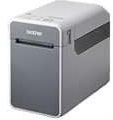
The Brother TD-2120N printer boasts direct thermal printing technology, delivering impressive printing resolution of 203 dpi. Under standard environmental conditions, this printer can churn out an impressive maximum print speed of about 152.4 mm per second. With a maximum print width of 56 mm and a maximum print length of 1 m, this device is ideal for a variety of printing tasks. However, the minimum print length should be at least 6 mm to ensure optimal printing performance.
Brother TD-2120N printer driver for Windows
| Filename | Size | Download |
| Printer Driver for Windows 7 8 8.1 10 xp vista 32 bit and 64 bit.exe | 25.96 MB |
Specifications
The printer’s physical structure is fitted with buttons for power, print, and feeder functions. On the other hand, its internal memory can hold up to 6 MB of data or a maximum of 99 templates. To facilitate control, the printer comes with P-touch template2.0, a raster, and the ESC/P control commands. The printer’s AC adapter acts as the primary power source, supporting a voltage range of 100 to 240 volts and a frequency of 50/60 Hz.
The printer boasts a sizeable yet portable design, perfect for those on-the-go. Its physical dimensions measure at 110 mm in width, 215 mm in depth, and approximately 172 mm in height, with a weight of around 1.32 Kg. The central connecting interface of the device is through a standard USB version 2.0 port, operating at full speed with a mini-B peripheral component. Regrettably, there are no alternative means of connecting with the printer.
In addition to the standard connectivity options, the printer supports the use of an original serial cable with model series number RS232C. However, for optimal performance, it is essential to ensure specific environmental conditions are in place.
During operation, the temperature range should be maintained between 5 and 400C. When the printer is not in use, it can be stored within a temperature range of -20 to 600C. The humidity level of the environment in which the printer is used should also be closely monitored and remain between 20 and 80% without condensation.
By adhering to these guidelines, users can be confident in achieving the best possible results from their printer.
